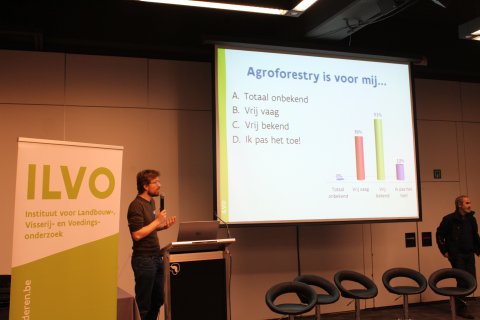Are trees not an obstacle for working on agricultural fields? Don’t they take all resources from the crops? Can we harvest them in the end? These are only a couple of questions discussed during the interactive agroforestry workshop held on the 10th of January at Agriflanders, a well-known agricultural fair in Ghent, Belgium.
The farmers who joined the agroforestry event at Agriflanders all realize that agriculture is experiencing quite some pressure and challenges these days, from an economic, environmental as well as climatic point of view. One of the reasons to visit this big agricultural fair, is to meet colleagues and search for means to tackle the challenges they experience.
 They were curious to hear if and how agroforestry can be part of the solution, but in the same time had a lot of doubts and questions related to this innovative agricultural system. That is what we discussed about during our event. In a first part, Bert Reubens (ILVO) explained what agroforestry exactly is about, gave an overview of the diversity of AF systems and the historical context in Belgium, and then tackled in detail the most frequently asked questions and concerns. This took place in an interactive way, with participants being able to vote for specific statements. In a second part, four agroforestry practitioners were given the floor to present their farm and fields, and were interviewed in order to understand their motivation, experiences, tips & tricks, lessons learnt.
They were curious to hear if and how agroforestry can be part of the solution, but in the same time had a lot of doubts and questions related to this innovative agricultural system. That is what we discussed about during our event. In a first part, Bert Reubens (ILVO) explained what agroforestry exactly is about, gave an overview of the diversity of AF systems and the historical context in Belgium, and then tackled in detail the most frequently asked questions and concerns. This took place in an interactive way, with participants being able to vote for specific statements. In a second part, four agroforestry practitioners were given the floor to present their farm and fields, and were interviewed in order to understand their motivation, experiences, tips & tricks, lessons learnt.
Jos De Clercq has an organic mixed farm (Natlandhoeve) in Sint-Truiden. His Limousin cows graze under 25 year old fruit trees, and more recently also walnut and chestnut trees were added to his agroforestry system. Louis-Marie Tennstedt, is a conventional arable farmer from Galmaarden and can be considered as one of the main agroforestry pioneers in Flanders. On his arable fields and grassland he grows a variety of trees, ao walnuts for quality wood. The organic cooperative agroforestry farm Pomona, where ao Koen Doggen and François Ongenaert are taking care of the farms and fields, combines arable and vegetable crop production with trees and shrubs both for fruit, nut and quality wood production. Last, Carl Adriansens has a mixed conventional farm with a couple of arable crops, as well as strawberry production and outdoor Mangalica pigs. This winter, he planted fruit and nut trees in the outdoor area for the pigs.
All farmers talked about the need to consider the trees really as a part of the overall production system, in order to end up with a high quality product. That means taking enough time for care, pruning, maintenance. The economic return on the long run remains uncertain, but all farmers stress that this also is the case for common agricultural products, and that diversification and differentiation more and more becomes an important strategy. Ecological benefits were also often stressed by the farmers, with functional biodiversity both above and belowground being mentioned in particular.
A more detailed report (in Dutch) can be found here.












